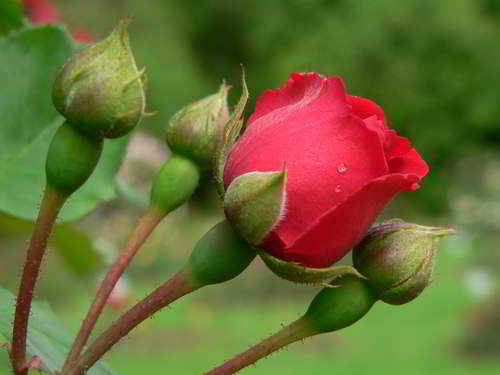Walking in the rose garden of the Botanical Garden, our visitors can enjoy more than 130 varieties of roses. Most of our roses are opening their petals now, and the flowers in all the colors of the rainbow are not only pleasing to the eye, but also have a very pleasant smell. Our collection includes tea rose hybrids with large, fragrant flowers, long-blooming floribunda and polyantha varieties with several flowers on their shoots, miniatures that are fashionable today, and renaissance roses with a penetrating fragrance. An interesting fact is that the memorial of St. Elizabeth of Árpádházi, bred in Hungary, is a rose variety. A novelty is our stem rose bed, which presents noble rose varieties based on the wild rose stem, which is located in the field outside the rose garden.
The rose garden pavilion decorated with running roses provides our visitors with a pleasant, shady resting place.
The Rose
The thousands of rose varieties that exist today are the result of many centuries of breeding work. The primary goal of breeding has always been to enhance the beauty of the flower, as a result of which the number and size of the petals in the flowers increased, and various flower shapes and colors were created.

Noble roses can have different growth forms. There are some that have preserved the bushy nature of wild roses, and there are also many varieties of running roses that spread out on the ground or grow long shoots.

Roses are popular not only for their color but also for their fragrance. The most fragrant varieties of roses are grown in a large area, and the very valuable rose oil is extracted from their petals, which is used in the highest quality cosmetic products. The most important oil rose growing country is Bulgaria, but there are also rose growing areas in the south of France, Algeria, and Morocco. A less well-known delicacy here, but popular in these countries, is jam made from rose petals or candied roses.

Noble roses rarely mature. Varieties are propagated mainly by seeding: the buds separated from the noble plant are placed as "seeds" on "stocks" of plants grown from wild rose seeds. With this method, the characteristics of the varieties can be preserved. Some varieties can also be propagated by rooting "cuttings" of shoot pieces. The area around Szeged-Szőreg is the country's most important rose-growing region.

Roses also have a symbolic meaning for many peoples. The opening rosebud, the fragrant flower, as a symbol of youth and beauty, the queen of flowers, has been immortalized in many literary and musical works.

An important medicinal plant is the common herbRosa canina), whose rosehip pseudofruit is used to make tea and jam. Hecsedli jam made from pork loin is a tasty treat and a rich source of vitamins.










